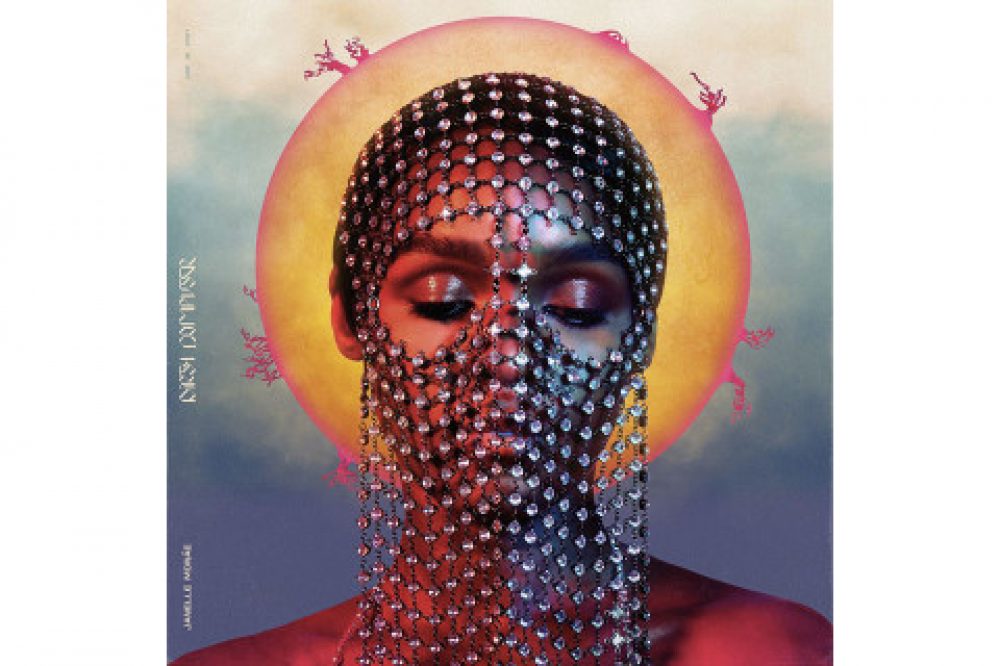For anyone who hasn’t watch The Fifth Element here’s a (hypothetically) brief synopsis/sequencing of the film. *spoiler alert*
- Outer Space: A “dark planet” casts a shadow on Earth.
- The Prophesy (Egypt, 1914): A white man decodes a prophesy that states: every 5,000 years, when the three planets are in eclipse, an evil black hole will appear. The only thing that will save the world is if a fifth element is joined with the four elements. An Egyptian Priest attempts to poison the Italian man because “he knows too much.” A spaceship lands, casting a shadow over everyone/everything. The Mondoshawans (“good” alien) retrieve “the stones” (the four elements) from Earth for safe keeping and promise to return in 300 years. The priest promises to fulfill his mission: to pass on this prophesy to the next priest. The white, male apprentice tries to shoot the Mondoshawans.
- The Failed Attack (New York City Headquarters, 300 Years Later): The president gives orders to destroy “the dark planet” by force, but this only increases its power.
- The Failed Robbery: We are meet Korben Dallas and see Fhloston Paradise advertised on TV. Someone tries to rob Korben’s apartment, but he turns the tables on the robber.
- The Mondoshawan’s Ship is Shot Down: The priest explains the threat of the “dark planet” to the president, stating that if “evil” stands in the middle of the four elements, instead of the fifth element, then “light turns to dark, life to death, forever.” The Mondoshawans’ spaceship is shot down by Aknot – the leader of the Mangalores, who are working for Zorg.
- The Fifth Element is Born: There is one “survivor” from the Mondoshawans’ ship: the fifth element. The fifth element is “reborn” as a white woman using the white, male scientists’ technology. She breaks free.
- The Chase Scene: The fifth element falls through the roof of Korben’s taxi cab and convinces him to help her escape.
- The Priest: Korben brings The Fifth Element to The Priest to recover. Korben tries to kiss the fifth element (Leeloo), but she does not Leeloo reveals that the stones have been stolen.
- Zorg’s Arms Deal: Aknot transforms from a black, male human into an ugly alien. He delivers a case this is supposed to contain the stones to Zorg, in exchange for weapons, but it is empty. Zorg is angry. The Mangalores are angry because they won’t get their weapons. Zorg gives them one case of weapons, but they don’t know how to use them.
- Zorg’s Lair: Zorg’s black bodyguards kidnap The Priest. Zorg and The Priest have a philosophical debate about good and evil. Zorg chokes on a cherry. The Priest saves his life. Zorg spares The Priest’s life, “for now,” and continues his quest for the stones.
- The Tickets: The Military General reveals to The President (and Zorg’s spy) that the stones are with “a diva” named Plavalaguna. Korben finds out he’s fired. The Military General enlists Korben to retrieve the stones from Fhloston Paradise by rigging a radio contest. The Priest and Leeloo arrive. Zorg’s minions kill Korben’s look-alike so that they can take his tickets to Fhloston Paradise. The Priest steals Korben’s tickets.
- The Flight: Korben replaces The Priest’s apprentice as Leeloo’s fake husband. They board the plane. The Mangalores try to board the plane as Korben, but are denied. Korben meets Ruby Rhod. Korben puts Ruby Rhod in a chokehold, making it known that he’s on a mission and he’s in charge. Zorg’s minion tries to board the plane as Korben, but is denied. Ruby brings a flight attendant to orgasm while the flight takes off.
- Shadow: Zorg takes a call from “Mr. Shadow” (his employer aka The Dark Planet) and promises to get the stones. His head starts to bleed.
- Fhloston Paradise: They arrive in Fhloston Paradise. The Priest in on the plane. The stones’ case is transported to a secret room. Ruby and Korben arrive at the Opera for Miss Plavalaguna’s performance. The Malangores are disguised as waiters. Zorg is granted permission to dock on Fhloston.
- The Heist: Leeloo prevents the Mangalores from stealing the stones, but Zorg steals the stones from Leeloo. The Mangalores take over the ship. Miss Plavalaguna is shot. She tells Korben that he must give Leeloo the stones, his help, and his love. Zorg realizes the stones are not in the stolen case. Miss Plavalanguna reveals that the stones are inside her. She dies. Korben takes the stones out of Miss Pavalanguna’s stomach and goes on a killing spree. Korben kills Aknot and rescues The Priest and Leeloo. Ruby finds the bomb Zorg planted. Everyone evacuates. Zorg returns to turn off the bomb, but a dying Mangalore turns the bomb back Fhloston explodes with Zorg and the Mangalores.
- Human Nature: Leeloo learns about war. The President calls Korben. He says they have 1 hour and 57 minutes before The Dark Planet collides with Earth and everyone dies.
- The 5 Elements Unite (Egypt): Korben, The Priest, The Priest’s apprentice, and Ruby activate the stones. Leeloo refuses to save humanity because of the inhumanity she has witnessed in the name of humanity. Korben tells Leeloo love is worth saving and confesses his love for her. They kiss. The five elements collide. Earth is saved and The Dark Planet is destroyed.
- Sex: The President comes to thank Korben and Leeloo, but they are in the Nuclear Reactor having sex.
Now that that’s over, let’s get to the fun stuff: analysis!
I chose to analyze the frame at timestamp 1:37:58 because it encapsulates a central tension in The Fifth Element: the fraught relationship between self and “other.” The film begins with a white man screaming the words “Aziz, LIGHT!” and ends with the triumph of light over dark, as encapsulated by the death of “The Dark Planet.” The two white characters, who achieve The Dark Planet’s destruction (Korben and Leeloo), are seen having sex to the sound track of Eric Serra’s “Little Light of Love” at the end of the mission/movie, climaxing to the lyrics “rely on your light, your interwoven power.” These lyrics seem to replace Ruby Rhod’s reference to Black Power (“Right on, right on”) in an earlier sexually-charged scene, suggesting a non-threatening, “loving” white power with the ability to achieve racial harmony (represented by the Black Presidency) through a colorblind, non-confrontational politics of assimilation.
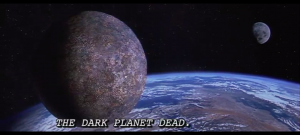
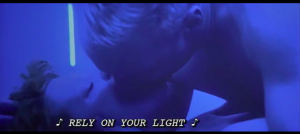
Dichotomies between light and dark, good and evil, black and white, human and alien, woman and man, and heterosexual and homosexual are apparent throughout The Fifth Element. But, nowhere are these distinctions more pronounced than in the relationship between Miss Pavalanguna and Korben Dallas. Miss Pavalanguna represents the absolute “other”: she is woman; she is alien; and, via her “colored skin” (blue pigment), she is coded non-white or a p.o.c. But, unlike the other absolute other in the movie: “Mr. Shadow,” who is described as “absolute evil,” she is held up as a symbol of absolute good: the most trustworthy, the most beautiful, the most talented, and, ultimately, the key to the continuation of society and humanity.
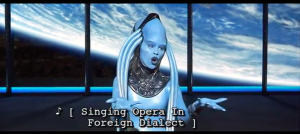
Nevertheless, her alien body – and its role in the movie – stand in stark contrast to Korben’s body, which epitomizes what mainstream society deems “normal” (i.e. human, heterosexual, white, and male). Despite her non-threatening, “mesmerizing” otherness, represented by her awe-inspiring effect on the audience in The Opera scene, Miss Pavalanguna does not escape the negative consequences of her otherness. Ultimately, like The Dark Planet, she dies in order to “save” humanity and her death is marked by the violence of Korben Dallas (i.e. white masculinity).
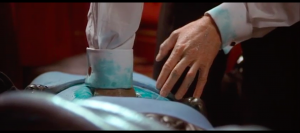
At 1:37:58, we see Korben’s fist – centered in the frame – penetrating Miss Pavalanguna’s dead body at a perfect, perpendicular angle to the bottom of the screen. He is “retrieving” the stones that she says, pre-death, are “in me.”
There is something deeply violent and deeply sexual about this scene. The cinematographer’s choice to shoot vertically (as opposed to horizontally) serves to expand the power asymmetry between Korben and Miss Pavalanguna. It maximizes the space Korben’s arm occupies on the screen, while, simultaneously, minimizing the presence of Miss Pavalanguna by obscuring the majority of her horizontally splayed body. Blue blood – the symbol of lost virginity – seeps out of the bullet hole in Miss Pavalanguna’s body, staining Korben’s white sleeve, another reference to lost virginity/purity.
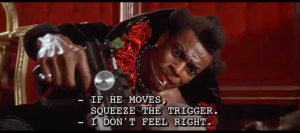
In the prior frame (at timestamp 1:37:44), Korben hands Ruby Rhod a gun and tells him to “squeeze the trigger” if the Mangalore, lying directly opposite Miss Pavalanguna (in the same, horizontal position), moves. Firing a gun often symbolizes ejaculation and male sexual prowess/power in film. Phallic symbolism seems especially fitting for this and the following scene given that Ruby, who engages in non-penetrative sex with the flight attendant and presents an effeminate masculinity, is afraid to shoot. Ruby’s inability to shoot (his impotency) is directly contrasted with Korben’s strong masculinity, as evidenced by the ease with which he penetrates Miss Pavalanguna’s body in the following frame. Korben inserts his arm into a hole in Miss Pavalanguna’s stomach, evoking the vaginal opening and sexual violence of the scene.
This scene asks us to question the gendered and raced violence that is inherent in a story about a white man “saving” the world from darkness. It begs the question who is sacrificed and who is saved in our society? Who has agency, which, at its most basic level, means, who lives and who dies, who penetrates and who is penetrated? The scene reminds us that – in a world build around sharp binaries between self and other – even the venerated other is susceptible to violence. Distinctions between Dark Planet and Diva, “good” hombre and “bad” hombre, model minority and menace are easily broken, as thin as a layer of soft, blue skin.
